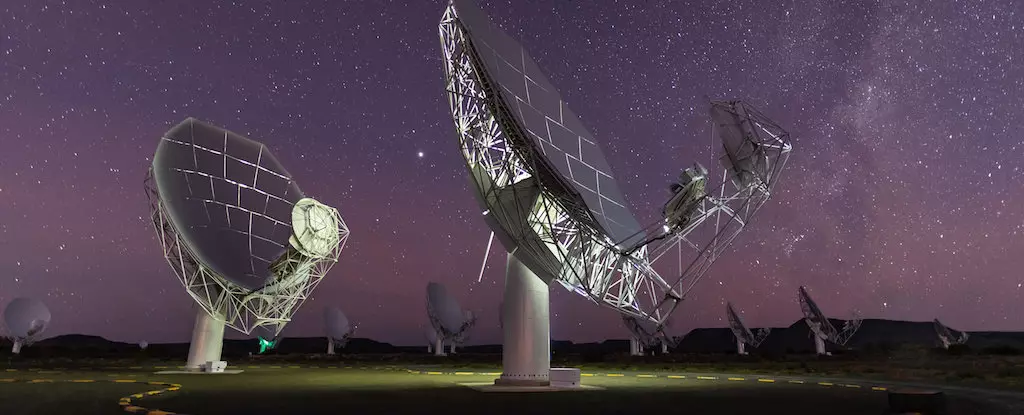Giant radio galaxies (GRGs) represent some of the most remarkable and vast structures found in the cosmos, with their sizes often stretching millions of light-years across the universe. Their sheer scale makes them the largest-known entities knit into the cosmic fabric, yet their immense proportions also contribute to their elusiveness. The challenge of locating these gargantuan phenomena has fascinated astronomers for decades, and a recent discovery utilizing the MeerKAT telescope in South Africa has amplified this intrigue. The newly identified giant radio galaxy, dubbed “Inkathazo,” defies conventional wisdom due to its extraordinary traits and an impressive measurement of over 3 million light-years from one end to the other, eclipsing the Milky Way’s size by more than 30 times.
The selection of the name “Inkathazo” stems from the galaxy’s troublesome nature as described by its discoverers. The term is rooted in isiZulu and isiXhosa, two languages indigenous to the Southern African region, and translates to ‘trouble.’ This choice is emblematic of the scientists’ struggles to decode the unusual characteristics and physics associated with this galaxy. Kathleen Charlton, the lead author of the study and a master’s student at the University of Cape Town, expressed the team’s challenges in understanding the underpinning mechanisms of Inkathazo’s gigantic behavior, which makes the discovery not just significant but layered with complexities.
The realm of radio galaxies is already rich with astrobiological phenomena, particularly involving supermassive black holes that consume matter at their cores, subsequently expelling immense jets of plasma that emit radio waves. While the classification of GRGs generally includes those exceeding 2 million light-years, Inkathazo’s peculiar features introduce a new layer of complexity. Notably, one of its plasma jets presents an unusual curvature rather than maintaining a straight extension typical of most radio galaxies. Such unexpected behaviors raise compelling questions regarding the traditional understanding of GRGs and challenge established models of galactic evolution.
The larger context of Inkathazo’s existence is equally astonishing, considering its residency among a cluster of galaxies. Typically, galactic clusters exhibit environmental conditions that inhibit the growth of massive jets; therefore, the presence of Inkathazo within such a setting adds another enigma to its discovery. Co-author Kshitij Thorat of the University of Pretoria remarked on the unexpected nature of this finding, stressing that it illuminates potential interactions between environmental factors and the formation of colossal radio galaxies.
To glean further insights into Inkathazo’s peculiarities, the research team utilized MeerKAT’s advanced capabilities to generate high-resolution spectral age maps of the galaxy. These innovative maps have crucial implications, as they can display the plasma’s ages across various regions of the galaxy. The results unveiled unexpected patterns within Inkathazo’s jets, revealing localized energy boosts impacting certain electrons. This phenomenon not only generates intrigue but hints towards external influences at play, suggesting that Inkathazo’s jets are interacting with the surrounding hot gases in its galactic cluster. These interactions could provide valuable clues regarding the mechanisms that govern such elusive phenomena.
In recent years, GRGs have transitioned from being considered rare cosmic occurrences to entities coming into the limelight with increasing frequency. The advent of sophisticated radio telescopes such as MeerKAT has been pivotal to this growth in discovery rates. Charlton noted that the proliferation of GRG observations has surged in the past few years, making it a rapidly evolving field in cosmic research. Interestingly, most prior detections have predominantly occurred in the Northern Hemisphere, yet the burgeoning discoveries in Southern skies, particularly with Inkathazo’s revelation, imply that vast reservoirs of unexplored cosmic wonders may still await astronomers.
Recent surveys have justified this optimistic conjecture, as highlighted by the simultaneous discovery of three GRGs from a single observation region utilizing MeerKAT. This underscores not just the efficacy of the equipment but suggests a potential treasure trove of undiscovered giants lingering in the southern celestial domain, as noted by researcher Jacinta Delhaize.
The discovery of Inkathazo reinforces the notion that our universe continues to hold profound mysteries, with each exploration leading to more intricate questions than answers. As scientists delve into the complexities of Inkathazo, they are faced with a unique opportunity to advance our understanding of giant radio galaxies and their intricate behaviors. With continuous advancements in observational technology and an ever-growing catalog of cosmic phenomena, one can only imagine what captivating revelations lie just beyond the horizon of our current scientific understanding.

